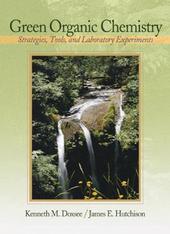
|
Green Organic Chemistry: Strategies, Tools, and Laboratory Experiments
Hardback
Main Details
| Title |
Green Organic Chemistry: Strategies, Tools, and Laboratory Experiments
|
| Authors and Contributors |
By (author) Kenneth M. Doxsee
|
|
By (author) James Hutchison
|
| Physical Properties |
| Format:Hardback | | Pages:256 | | Dimensions(mm): Height 277,Width 214 |
|
| Category/Genre | Organic chemistry |
|---|
| ISBN/Barcode |
9780534388515
|
| Classifications | Dewey:547.0078 |
|---|
| Audience | | Tertiary Education (US: College) | |
|---|
| Edition |
New edition
|
|
Publishing Details |
| Publisher |
Cengage Learning, Inc
|
| Imprint |
Brooks/Cole
|
| Publication Date |
7 May 2003 |
| Publication Country |
United States
|
Description
Developing the green organic program at the University of Oregon, Kenneth Doxsee and James Hutchison saw the urgent need and rapidly growing demand for green chemistry laboratory materials. This lab text describes the tools and strategies of green chemistry, and the lab experiments that allow investigation of organic chemistry concepts and techniques in a greener laboratory setting. GREEN ORGANIC CHEMISTRY: STRATEGIES, TOOLS AND LABORATORY EXPERIMENTS was developed and successfully tested as a direct replacement of the traditional organic chemistry laboratory curriculum. Thus, the conceptual themes and experimental techniques important to the modern practice of organic chemistry can be taught in the context of more environmentally-benign laboratory experiments. Students acquire the tools to assess the health and environmental impacts of chemical processes and the strategies to improve develop new processes that are less harmful to human health and the environment. The curriculum introduces a number of state-of-the-art experiments and reduces reliance on expensive environmental controls, such as fume hoods.
Author Biography
Dr. James Hutchison has been on the faculty at the University of Oregon since the fall of 1994. He and Dr. Doxsee are the chief architects of the UO's nation-leading program in "green" (environmentally-benign) organic chemistry. He also helped establish the University of Oregon's Materials Science Institute Graduate Internship Program in Semiconductor Processing. He and his research group design and prepare new functional materials. His specific research interests include preparation and study of nanoscale materials, surface and polymers, for applications such as nanoelectronics, biocompatibility and environmental remediation. Before joining the faculty at the University of Oregon, he was a National Science Foundation postdoctoral fellow with Prof. Royce W. Murray at the University of North Carolina at Chapel Hill. He received his PhD in 1991 at Stanford University under the direction of Dr. James P. Collman. His undergraduate degree, a B.S. in chemistry, was completed in 1986 at the University of Oregon. Recently he was promoted to the rank of associate professor and has been named an Alfred P. Sloan research fellow and a Camille Dreyfus teacher-scholar. Previous awards include an NSF-CAREER award and a Dreyfus New Faculty Award. He is the author of over 55 refereed publications, three patents and three book chapters. Dr. Kenneth M. Doxsee has been actively involved in undergraduate organic laboratory curriculum development and teaching throughout his academic career. He and Dr. Hutchison together designed and developed the University of Oregon's groundbreaking program in "green" (environmentally benign) organic chemistry. His research efforts are focused on the development of new and environmentally benign methods for the synthesis of solid-state materials with designed control of crystal form, size, and composition. He earned his B.S. (1978) and M.S. (1979) degrees from Stanford University under the direction of James P. Collman and John I. Brauman and his Ph.D. (1983) from the California Institute of Technology, with the support of a Hertz Foundation graduate fellowship, under the direction of Robert H. Grubbs. Following an American Cancer Society postdoctoral fellowship at the University of California at Los Angeles, working with Donald J. Cram, he moved to the University of Southern California in 1985, and then to the University of Oregon in 1989, where he holds the rank of Professor of Chemistry. He and Dr. Hutchison were awarded the Outstanding Teacher of Science and Mathematics in Higher Education award by the Oregon Academy of Science in 2003. He is the author of over 50 refereed publications and book chapters and three patents.
ReviewsBrief Table of Contents. Graphical Abstracts for the Experiments. 1. INTRODUCTION. 2. IDENTIFICATION AND EVALUATION OF CHEMICAL HAZARDS. 3. CHEMICAL EXPOSURE AND ENVIRONMENTAL CONTAMINATION. 4. SOURCES OF INFORMATION ABOUT CHEMICAL HAZARDS. 5. INTRODUCTION TO GREEN CHEMISTRY. 6. ALTERNATIVE SOLVENTS. 7. ALTERNATIVE REAGENTS. 8. REACTION DESIGN AND EFFICIENCY. 9. ALTERNATIVE FEEDSTOCKS AND PRODUCTS. 10. THE BIG PICTURE AND GREEN CHEMISTRY METRICS. Laboratory Experiments. 11. PREFACE TO THE EXPERIMENTAL SECTION. Experiment 1: Solventless Reactions: The Aldol Reaction. Experiment 2: Bromination of An Alkene: Preparation of Stilbene Dibromide. Experiment 3: A Greener Bromination of Stilbene. Experiment 4: Preparation and Distillation of Cyclohexene. Experiment 5: Synthesis and Recrystallization of Adipic Acid. Experiment 6: Oxidative Coupling of Alkynes: The Glaser-Eglinton-Hay Coupling. Experiment 7: Gas-Phase Synthesis, Column Chromatography and Visible Spectroscopy of 5,10,15,20-Tetraphenylporphyrin. Experiment 8: Microwave Synthesis of 5,10,15,20-Tetraphenylporphyrin. Experiment 9: Metallation of 5,10,15,20-Tetraphenylporphyrin. Experiment 10: Measuring Solvent Effects: Kinetics of Hydrolysis of tert-Butyl Chloride. Experiment 11: Molecular Mechanics Modeling. Experiment 12: Electrophilic Aromatic Iodination. Experiment 13: Palladium-Catalyzed Alkyne Coupling/Intramolecular Alkyne Addition: Natural Product Synthesis. Experiment 14: Resin-Based Oxidation Chemistry. Experiment 15: Carbonyl Chemistry: Thiamine-Mediated Benzoin Condensation of Furfural. Experiment 16: Solid-Phase Photochemistry. Experiment 17: Applications of Organic Chemistry: Patterning Surfaces With Molecular Films. Experiment 18: The Friedel-Crafts Reaction: Acetylation of Ferrocene. Experiment 19: Combinatorial Chemistry: Antibiotic Drug Discovery. Appendix A: The Twelve Principles of Green Chemistry.
|